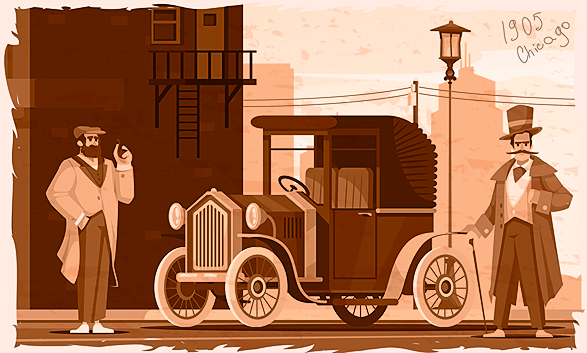Hello to animation history, where creativity rises, and the imagination takes over the screen. We have seen animation for years now attracting audiences and stoking creativity. It has developed from its modest beginnings to the medium of business videos. Join us on the journey as we explore the history of animation, looking for its roots, innovations, and great impact on how humans visually express themselves. Get ready to discover the mysteries of the fascinating world of animation, where imagination meets innovation.
What Is Animation?
Animation is using moving images to make inanimate things or representations alive. Animation techniques use pictures and drawings to give the impression of movement while telling a story to the audience. Some people think that the animated scenes and facial expressions found on the surface of early Greek pottery represent an early form of animation.
The History Of Animation
When did animation start? When individuals discovered that rapidly paging through images of objects that slightly shifted might provide the impression of movement, it was 4,000 years ago that animation started. The portrayed figures’ positions were repeatedly altered in Greek and Egyptian ceramics to depict movement.
The magic lantern was created in 1659 by a Dutch physicist named Christiaan Huygens to tell stories using moving images projected onto a screen. In the eighteenth century, shadowgraphy—a fresh approach to animating objects—emerged in France. This method employed hand-drawn shadows, which viewers referred to as “cinema in silhouette.”
In 1832, Joseph Plateau created the phenakistoscope. It was the first tool that could produce fluid animations, reviving interest in animation among the general audience.

Early Stages
From 1888 until 1914, modern animation was in its infancy. During this time, crudely animated movies using rudimentary technology were produced. Émile Renauld obtained a Theatre Optique patent in 1888 to use with his animated pictures. He produced several animated movies with a running time of 10 to 15 minutes and 300 to 700 painted frames.
Now you must be wondering when was the first animation made. The praxinoscope, an optical toy made of a cylinder and a strip of paper with twelve frames of animation, was also created by Renauld. Pauvre Pierrot by Renauld is typically regarded as the first animated movie. The inventor used individual, hand-painted graphics rather than computer-generated images to create the animations.
The Age Of Traditional Animations
The popularity of celluloid animations increased in the first half of the 20th century. Animators used images painted or drawn on transparent sheets of cellulose, camphor, and nitrate between 1914 and 1967.
These conventional cartoons used celluloid-drawn characters overlaid on celluloid backgrounds to reduce production time and the required number of frames.
The stop-motion animation technique also altered the history of animation production. Through this technique, lifeless, three-dimensional things appeared to be moving, giving the impression that they were alive.
The First Animated Films
The first full-length animated film was created in 1937 by Walt Disney Animated Studios. Traditional animation was utilized in Snow White and the Seven Dwarfs, with 2D images printed on translucent celluloid sheets. Two years later, Walt Disney won eight Oscars for this animated classic.
Puss Gets the Boot, a cartoon created by William Hanna and Joseph Barbera in 1940, inspired the well-known Tom and Jerry animations. They established Hanna-Barbera Productions, Inc. as a partnership in 1957. This animation studio and production company specializes in producing animated TV series for kids.

The Age Of Computers And Motion Graphics
Traditional animations began to be replaced by computers and motion graphics between 1967 and 1984. People used the technology for scientific and research reasons as early as 1940, when experiments with computer graphics were first conducted.
The late 1950s saw the construction of a mechanical analog computer system by John Hales Whitney, Sr., widely considered one of the pioneers of computer animation. Although crude, his tool could accurately and precisely generate lines and forms.
The 1967 film Hummingbird was the first to be created using computers. In the ten-minute film, which used computers to generate 30,000 pictures and 25 motion sequences, digital morphing was used to distort and merge one image into another to give a sensation of movement.
Computer Animation Product System (CAPS)
The Walt Disney and Pixar enterprises collaborated to develop the Computer Animation Product System in the late 1980s through their steadfastness in vision. The Little Mermaid by Walt Disney was the first full-length cartoon created using CAPS. The arrival of CAPS provided animators with new opportunities and allowed for the creation of innovative animation techniques.
The Modern Age Of CGI
Modern computers’ introduction has increased the popularity of animation. The standard of computer animations evolved as more production companies learned about their possibilities, eventually giving rise to computer graphics known as computer-generated imagery, or CGI.
Modern computer animation has almost entirely supplanted the stop-motion method used in the initial stages of animation. Modern computers produce 2D and 3D animation graphics that are animated using various techniques, such as frame-by-frame or rigging. Additionally, CGI enables animators to produce and produce animated films more quickly.
Shadow mapping was employed in Pixar’s 1986 short animated film Luxo Jr. to highlight changing light and shadows. The procedural animation used in the movie altered how production firms perceived digital animations. In the history of animation production, Luxo Jr. became the first CGI film to be shortlisted for an Academy Award.
Brand Video Animation
The influence of animation in the world has grown beyond just amusement as computer-generated imagery (CGI) animation technology has continued to progress. Today, branded animated video content is widely used in the video marketing and advertising sectors.
The cost of creating animated branded videos is typically lower than that of traditional advertising. It has demonstrated to be very successful at engrossing and capturing target audiences. As a result, animation has developed into a helpful tool for companies looking to advertise their goods and services.

When Was The First Animation Made?
“The Pauvre Pierrot” (1892) by Émile Reynaud was produced using a larger image roll for the praxinoscope. Reynaud’s picture roll for Pauvre Pierrot was hand-painted with 500 individual images instead of using photographs, which is why it is frequently cited as the first animated film.
The first animated film, however, is considered to be Émile Cohl’s Fantasmagorie (1908), which, in the opinion of film historians, is the earliest example of a motion picture produced using traditional animation techniques. Some contend that British-American J. Stuart Blackton’s Humorous Phases of Funny Faces (1906), the first animated film, was created.
Blackton used stop-motion animation to illustrate many animated characters throughout the three-minute movie. “Humorous Phases of Funny Faces” was the first animated film to be technically captured on real film using a normal picture camera.
The Rise Of Animation In The Advertising Industry
Nowadays, various animation and motion graphic trends can be seen in sales and marketing. But you might be wondering when it all began. At that time, Disney created several well-known cartoon characters, including Mickey Mouse, Bugs Bunny, Popeye, and many others. The 1920s through the 1960s were the height of American animation in terms of history.
Animation made its debut in a TV advertisement in 1940. Consider the 1950s icons Trix Rabbit, Cap’n Crunch, and Mr Clean. All three are still around today. It is the origin of everything. Now let’s look at how marketing animation has changed throughout time.
Animation In The Advertising Industry Today
Animation is being used to communicate with and retain customers. Animated ads help easily understand complex business topics and enhance the clarity of a brand’s message.
Animation presents numerous chances for businesses to provide an exceptional first impression. Explainer videos for the company are quickly becoming essential to a successful digital marketing plan and an effective product pitch.
Many businesses create heroes and offer them as brand ambassadors in animated ads, considering the impact of strong connections on brand-building methods in customers’ minds. With its special charms and quirks, remarkable character design represents the epitome of the brand personality.
It contributes greatly to a brand’s image and recognizability and, like a logo, forms an element of brand identification. Learn about James, the primary character of a recent Explain Ninja commercial for Zense.
Companies like Apple, Hubspot, Dropbox, and Coke began employing animated videos with moving graphics and characters to describe their brand’s history and evolution. The animation was introduced into their narratives to disrupt how traditional brands marketed and interacted with the public.
Animation Styles Used In Branded Video Content
Character Animation
The brand and goods are represented through character animation. Because there are fewer opportunities to produce a video for brand marketing, individuals start to choose character animation to approach their target audiences, leading to the highly competitive nature of this animation style during the COVID-19 era.
Animated Ads For Websites And Social Media
Such animation content is employed to draw in the target market. Videos and animation advertisements might help land pages on websites and social media networks. Advertising that uses animation has been demonstrated to improve website traffic and enhance sales conversions, which has a beneficial effect on Google search results.
The Future Of Animation
How long has animation been around since then? It has made developments, but it continues to grow and develop each year. Innovative technologies like virtual reality have a huge impact on animation. The animators are continuously figuring out new ways to integrate new technology into animation.
Animation is now used in various media, including marketing, video games, education, etc. Unlike its early stages, animation is not confined to film and television now. These areas now spread out more than ever just because of virtual reality, which gave animators new options for animating objects. Virtual reality is very interactive and aims to fully engage the user in a new environment.
As a result, animation has changed since it is now more lifelike than before. Whiteboard animation, the blending of virtual reality and live-action animation, and even interactive animation are examples of prior styles and methods that animators can use to create completely new experiences and types of animation.
A great example of a TV program that uses animation that seems highly realistic is Love, Death & Robots. Hyper-realistic animation is also growing in popularity. Historically, the goal of animation has been to produce distinctive, ludicrous, and visually appealing cartoons. To express their stories, many animators now try to produce hyper-realistic cartoons thanks to technological advancements.

Wrap Up
The history of animation is rich. It has come a long way from its beginnings in entertainment. Animation is one of the most effective marketing and advertising strategies for making brands stand out in the crowded media landscape because it is entertaining, non-sales, and motivating.
Customers grin, remember, and engage with a brand as a result. It’s the best method to modernize your brand, move away from conventional consumerism, and move toward marketing that is more focused on the needs of people. Only how courageous are you to try new things? If you are looking for help in animation, do look for an expert animated motion graphics firm who specialize in 2D animation and 3D animation and provide quality animations that help your brand message grab your target audiences.




